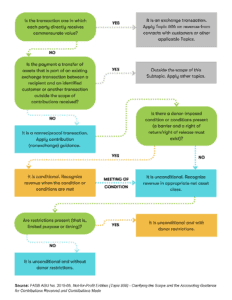Changes to Revenue Recognition Guidance
Revenue recognition (“Rev Rec”) principles changed with the implementation of FASB Accounting Standards Update (ASU) 2014-09, Revenue from Contracts with Customers (Topic 606), which replaced substantially all preexisting Rev Rec guidance. Topic 606 applies to all entities—including nonprofits—that enter into “contracts with customers” to transfer goods or services (i.e., exchange transactions). Classifying transfers for assets as exchange transactions or contributions, or a combination of both, is often challenging for nonprofits.
As this guidance can be challenging to navigate, here are some reminders on Rev Rec for nonprofits:
- Unless contracts are within the scope of other standards (e.g., contributions or leases), the impact of Topic 606 should be considered.
- Remember, guidance for Contributions was not changed by Topic 606 and still falls under ASC 958-605, Not-for-Profit Entities—Revenue Recognition.
- In preparing to implement Topic 606, many readers of nonprofit financial statements noted difficulty in characterizing grants and contracts. In response, the FASB issued ASU 2018-08, Not-for-Profit Entities (Topic 958): Clarifying the Scope and the Accounting Guidance for Contributions Received and Contributions Made, which aimed to clarify the following:
- How to determine whether you have an exchange transaction or a contribution.
- How to differentiate between conditional and unconditional contributions.
- Differences between a donor’s condition and a donor’s restriction—they are different!
- See the flowchart below for a diagram that should be followed when assessing the proper treatment of your grant or contract.

- For a contribution to be considered conditional, it must include both of the following:
- A barrier that must be overcome and;
- Either a right of return of assets transferred or a right of release of a promisor’s obligation to transfer assets
- Indicators of a barrier include:
- Measurable performance-related requirements
- Stipulations that the recipient is entitled to the assets only upon the occurrence of an identified event (e.g., a matching requirement)
- Stipulations that substantially limit discretion by the recipient on the conduct of an activity
- Limited discretion is more specific than general activities conducted by the recipient or the time frame in which the contribution must be used.
- Administrative tasks and trivial stipulations are not barriers/conditions.
- Determination of whether there is a donor-imposed restriction should include consideration of how broad or narrow the purpose of the agreement is and whether the resources are available for use only after a specified date.
- Nonprofits must carefully assess whether the recipient organization has paid consideration commensurate with the value of the assets, rights, or privileges received. If commensurate, the transfer (or a portion of the transfer) is an exchange transaction under Topic 606.
- Certain transactions are easy to distinguish. For example:
- Sales in a museum’s gift shop are exchange transactions.
- Donations received from a fundraising campaign are contributions.
- Other transactions may be more complex or contain elements of both exchange transactions and contributions—for example, sponsors of an event who receive a naming opportunity.
- Certain revenue streams previously treated as exchange transactions may now be classified as contributions after implementation of ASU 2018-08 (for example, grants from the federal government).
Partnering With a Trusted Advisor
Understanding revenue recognition principles is crucial in the wake of Topic 606 and subsequent clarifications, including ASU 2018-08. Navigating the complexities of classifying revenues as exchange transactions or contributions requires careful evaluation of whether or not commensurate value has been exchanged, and whether or not donors have imposed conditions or restrictions. Having personalized guidance from trusted advisors, like those at Perkins & Co, becomes invaluable in this intricate landscape. Our goal is to help you ensure accurate financial reporting, transparency, and accountability, instilling confidence in your stakeholders and donors. By partnering with experts, nonprofits can focus on fulfilling their missions and doing what they love, knowing their financial matters are in capable hands.
Alex Mahan, CPA, has more than 15 years of experience in audit and accounting, serving clients across many industries. Throughout her career, Alex has enjoyed working with numerous nonprofits, including foundations, arts organizations, membership associations, and other social welfare-focused entities. Do you have questions about our services for nonprofits? Check out our nonprofit service offerings and contact us today.

